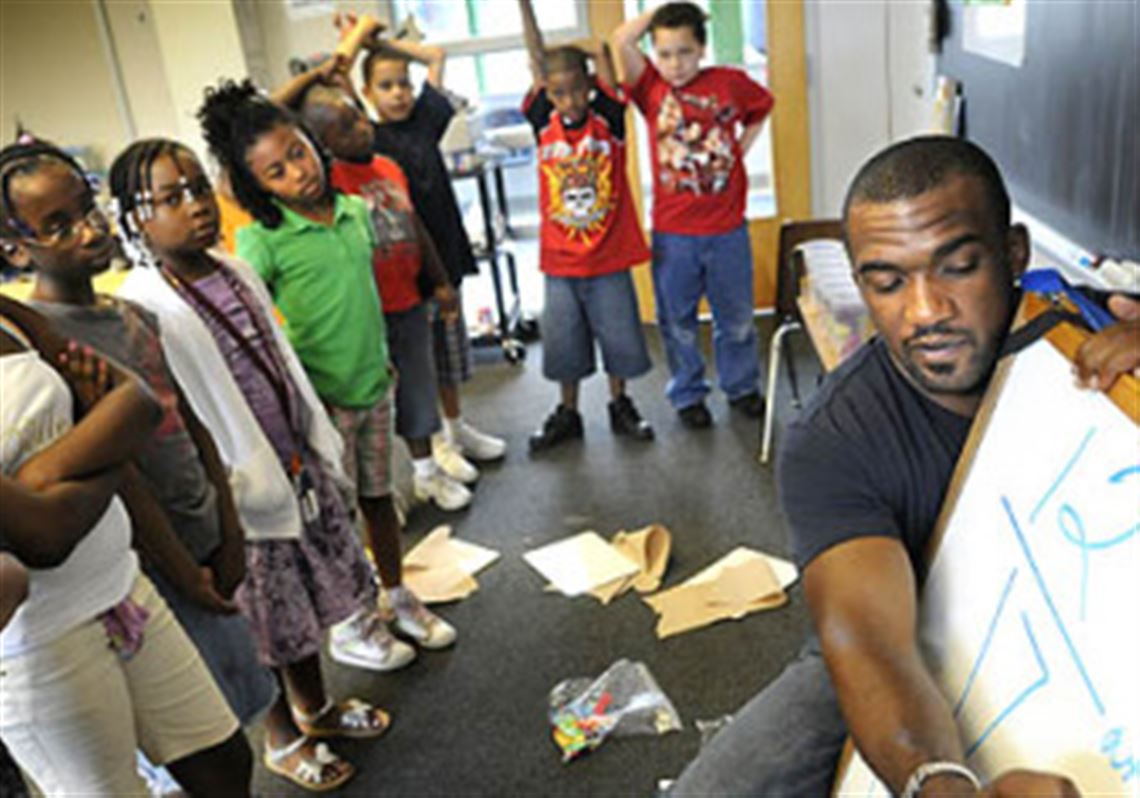Math teacher Christopher Warden drew four stick figures on the board to represent a group of friends and six circles to represent a half-dozen cookies.
The question to be noodled around by about a dozen rising Pittsburgh seventh-graders at a summer-school class in June, was this:
"How can four friends share six cookies equally?"
Underlying that problem -- and hundreds like it tackled in classrooms nationwide each year -- is a far-more-important one:
Why do American students have difficulty grasping fractions, and how can teachers best get the material across?
DO THE MATH
The Series
The implications are serious. According to last year's report of the National Mathematics Advisory Panel appointed by the president, difficulty with fractions is impeding America's overall progress in math, which, in turn, raises national security concerns and questions about the country's economic vitality.
There are personal repercussions, too. Knowledge of fractions is needed to cook, measure for home-improvement projects, calculate sales prices, understand taxes and earn a living in an increasingly technical work world.
Ever looming, too, is the possibility of having to apportion six cookies among four friends. (Each gets 1 1/2 cookies.)
Eric Rogalsky, a math coach who taught summer school with Mr. Warden at Pittsburgh Sunnyside K-8 in Stanton Heights, said he tells students about fractions:
"You're going to use this stuff for the rest of your life."
Experts have advanced a number of reasons to explain students' difficulty with fractions. For starters, fractions are mind-benders for youngsters accustomed to working with whole numbers.
"One reason fractions are difficult is that you can't count them. There are an infinite number of fractions between any two fractions or any two whole numbers," said Robert Siegler, professor of cognitive psychology at Carnegie Mellon University and a member of the math panel.
As Mr. Warden said, "1 is always 1. It represents one object." Fractions muddy the waters, he said, noting 1/2 can refer to one pizza or to a set of pizzas.
Fractions seem counterintuitive.
Mr. Rogalsky said it can be difficult to understand that the larger the denominator, the smaller the fraction. For example, 1/2 is larger than 1/5, which is larger than 1/8.
That kind of confusion is nothing new. In his book "In the Heart of the Sea," Nathaniel Philbrick said some greenhorns who signed up for 19th-century Nantucket whaling voyages cheated themselves out of pay by believing it was better to accept 1/32 of a voyage's proceeds than 1/25.
For perspective, teachers and students may plot fractions on a number line, said Glenda Lappan, a professor at Michigan State University's Division of Science and Mathematics Education and co-author of the Connected Mathematics series of instructional materials.
Teachers also use "fraction strips" made of plastic or cut from sheets of paper. By lining up strips marked "1/2," "1/3" and "1/5," students can see the size differences.
With whole numbers, multiplication always means more -- 6 x 8 = 48 and 10 x 10 = 100. But with fractions, that maxim is out the window.
What is 1/2 x 1/3?
"First of all, it has to be smaller than 1/3," said Steve Ritter, chief scientist at Carnegie Learning Inc., an Oakland developer and publisher of math instructional materials.
The question, he noted, also can be expressed as, "What is 1/2 of 1/3?" The answer is 1/6.
Problems involving fractions may require numerous steps -- prospective traps all. Students have to decide whether to add, subtract, multiply or divide; when to employ the lowest common denominator and how to find it; when to reduce fractions; and how to solve for decimals and percents.
One student at Sunnyside successfully performed a series of mathematical operations -- but it was the wrong series for the problem under discussion.
"Your math was right. Unfortunately, the question was different," Mr. Rogalsky said.
In their report, Dr. Siegler and other math panel members said fractions are one of the "critical foundations" for algebra, which they called a "demonstrable gateway" to later achievement.
The panelists said schools were failing to prepare students for algebra, in large part because they weren't teaching fractions effectively.
"Difficulty with fractions (including decimals and percent) is pervasive and is a major obstacle to further progress in mathematics, including algebra," they said.
The panel's recommendations included the following:
By the end of fourth grade, students should be able to represent fractions and decimals and plot them on a number line; by the end of fifth grade, they should be able to add and subtract fractions and decimals; by the end of sixth grade, they should be able to multiply and divide them; and by the end of seventh grade, they should be able to tackle rate, ratio and proportionality.
The panel said that timetable would position students for algebra by eighth grade.
The report also offered suggestions for how to teach fractions and the other critical foundations of algebra -- whole numbers and certain aspects of geometry and measurement -- by giving ample attention to both theory and application.
Stress the former, and students have a difficult time parlaying concept into practice. Stress the latter, and students don't know why some operations require a common denominator and others don't.
Teachers "need to help children understand what fractions mean and how numeric symbols correspond to magnitude before they start teaching them how to execute arithmetic algorithms," Dr. Siegler said.
At a young age, students have an ability to understand the basic concept of fractions, and some districts try to take advantage of that.
Hampton Township School District introduces fractions in kindergarten with discussions about days of the week and months of the year.
That's followed in first grade by the use of drawings to discuss halves, thirds and fourths and by the use of whole numbers and fractions to represent quantities.
In second grade, students learn about money and identifying parts of a group.
In third, they write fractions and mixed numbers; use fraction strips to compare and order fractions with like and unlike denominators; and get a look at probability.
In fourth grade -- ahead of the math panel's recommended timetable -- students tackle addition and subtraction of fractions with like and unlike denominators.
If time allows, third-graders may explore that subject matter, too, like they did late last school year in Loriann Palmer's classroom at Central Elementary. In an upbeat, encouraging tone, Ms. Palmer led students through a series of problems using stick figures, "cookies" and "pans of brownies."
During such lessons, students typically start by drawing lines from the stick figures to the cookies or brownies, quickly apportioning whole items. When there no longer are enough cookies or brownies to go around, students subdivide the leftover items and apportion the pieces.
A teacher often gives students the latitude to solve problems the way they want, while requiring them to talk through their work to make sure the entire class understands the theory and operations behind the answer.
Sometimes, teachers hurry through a problem and solve it themselves instead of giving students a chance to figure it out, Dr. Ritter, of Carnegie Learning, said. In those cases, he lamented, a learning opportunity becomes little more than a "magic trick."
Because students can easily relate, food -- real and hypothetical -- features prominently in elementary school lessons about fractions.
One day last school year, Kesete Thompkins, a third-grade teacher at Manchester Academic Charter School, gave students cups of fruit to spill out onto paper towels.
They counted each variety and related it to the whole, an exercise designed to help them understand the concept of numerator and denominator. Then, in a happy lesson in subtraction, they ate the oranges, apples, cherries and grapes.
M&Ms, pies and pizzas are used to teach fractions, too. (If a student has trouble telling whether 1/2 or 1/3 is larger, cut up a pizza and ask which part he'd rather have.)
"I talk about pizza all the time," Mr. Warden said.
First Published: August 31, 2009, 8:00 a.m.

















